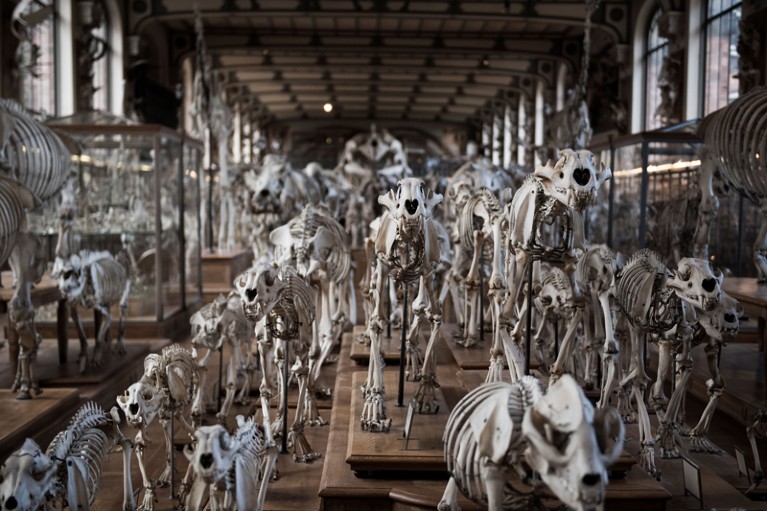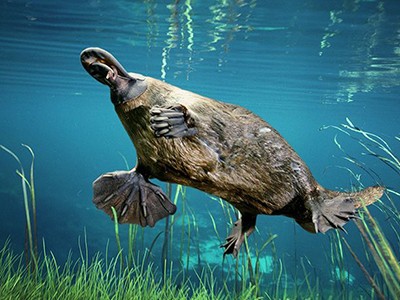
Genome scientists aim to leave no animal or plant behind in conservation push.Credit: Marin Bureau/AFP/Getty
An ambitious project launched last week aims to slow the decline in biodiversity by sampling and decoding the DNA of every species of plant and animal on Earth. Called the Earth BioGenome Project, the effort is seeking funding to help it get off the ground. It is asking for US$4.7 billion to sequence all 1.35 million known eukaryotic species — those with a cell nucleus enclosed by a membrane — over the next 10 years.
Given the colossal scale of the crisis that faces life on the planet, genomics might seem an unlikely saviour. Biology has certainly advanced to a different realm since physicist Ernest Rutherford’s famous quip that science was either physics or stamp collecting. But how much — really — can reading the DNA sequences of species save the organisms from the threat of climate change, the destruction of their habitats or human over-exploitation of natural resources through fishing and farming? To someone with a hammer, every problem looks like a nail. Are scientists with DNA-sequencing machines falling for the same logical fallacy? Is this a project that is being done because technology means that it now can, rather than because the need for conservation says that it must?
‘Why not sequence everything?’ A plan to decode every complex species on Earth
The organizers have yet to make their case fully — after all, the project is still on the drawing board — but the early signs suggest that it is worthwhile. Yes, it is likely to be relatively expensive to accomplish fully, but so is much of modern science on a grand scale. In today’s money, the Human Genome Project cost $5 billion, and few people would argue that this was not money well spent. The construction of the Large Hadron Collider, which discovered the Higgs boson, cost about the same amount. (And as Harris Lewin, the organizer of the London launch of the Earth BioGenome Project, provocatively asked: “What has the Higgs boson done for you lately?”)
What can genomics do for conservation? Quite a lot, actually, and the vast scope of the project can easily obscure the intensely local insights that might emerge. To point to one small example reported this year, an analysis of 3,095 DNA variations called single nucleotide polymorphisms in the genome of the endangered eastern tiger salamander (Ambystoma tigrinum) in Long Island, New York, found that, because roads were restricting the animals’ movement between breeding ponds, genetic fragmentation of populations was occurring (E. McCartney-Melsad et al. Preprint at Bioarxiv http://doi.org/gdcd5x; 2018). The finding highlighted the need for conservation efforts to focus on mitigating this development.
But so far, scientists have just scratched the surface in terms of the diversity of organisms sequenced. And sequencing technologies are only now mature enough to generate high-quality (complete) genomes for in-depth studies. Of the 33,000 genomes in the archives of the US National Center for Biotechnology Information (which represent 0.2% of eukaryotic species diversity), only 50% are of high quality.
Arguably, the highest-quality (and the most expensive) genomes are not strictly necessary for conservation efforts to benefit, but they might reveal the route to new biofuels, drug leads and useful agricultural traits. Finding such applications, and so presenting the conservation of biodiversity as a boon to national economies, local cultures and the environment, should further help governments to take biodiversity issues even more seriously.
Certainly, the need is urgent and the statistics alarming: 50% of current biodiversity could be lost by the end of the century. Earth’s sixth great extinction event is firmly under way, and ending this crisis will take much more than DNA sequences. But the Earth BioGenome Project can play a part, and early signs are that it might work.
It is right to seek commitment from participants, by asking them to chip in with money from their own grants. And a good sign is that it’s not a top-down monolith. Unlike a typical genome-sequencing project, it has come together as a grass-roots initiative, driven by individuals who study diverse groups of organisms and who are already working to sequence the organisms’ DNA. The new project includes ongoing efforts such as i5K (insects), B10K (birds) and the Darwin Tree of Life project, which aims to sequence all of the estimated 66,000 eukaryotic species in the United Kingdom. That suggests the pay-off could come more quickly because many of the genomes are already targeted by research communities keen to process and annotate them.
One looming issue is how easy it will be to transfer samples and genetic data across national borders. A meeting of the United Nations Convention on Biological Diversity (CBD) in Egypt later this month will consider new controls on the sharing of digital genetic data. The proposals would extend the reach of the 2014 Nagoya Protocol, which provides for equitable sharing of the benefits obtained from using genetic resources. If properly implemented, such rules will create greater legal certainty and transparency for the countries that provide such resources and the scientists and companies that use them. They will also help to boost local scientific capacity in the many poorest countries that hold some of the world’s richest biodiversity.
Extending the protocol to cover genetic data makes sense, but, if done clumsily, it could create a mess. The CBD has to its credit held extensive consultations with scientists and research institutions likely to be affected. The Earth BioGenome Project could help, by speaking as one voice for researchers. It’s better to have one international effort to negotiate solutions for data sharing, instead of a hotchpotch of complex individual and bilateral agreements. And that will help to ensure that the Earth BioGenome Project really does benefit the entire Earth.

 ‘Why not sequence everything?’ A plan to decode every complex species on Earth
‘Why not sequence everything?’ A plan to decode every complex species on Earth
 Biodiversity moves beyond counting species
Biodiversity moves beyond counting species
 CRISPR hacks enable pinpoint repairs to genome
CRISPR hacks enable pinpoint repairs to genome


